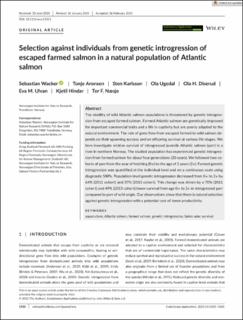Selection against individuals from genetic introgression of escaped farmed salmon in a natural population of Atlantic salmon
| dc.contributor.author | Wacker, Sebastian | |
| dc.contributor.author | Aronsen, Tonje | |
| dc.contributor.author | Karlsson, Sten | |
| dc.contributor.author | Ugedal, Ola | |
| dc.contributor.author | Diserud, Ola Håvard | |
| dc.contributor.author | Ulvan, Eva Marita | |
| dc.contributor.author | Hindar, Kjetil | |
| dc.contributor.author | Næsje, Tor | |
| dc.coverage.spatial | Atlantic, northern Norway | en_US |
| dc.date.accessioned | 2021-05-27T09:25:03Z | |
| dc.date.available | 2021-05-27T09:25:03Z | |
| dc.date.created | 2021-05-25T12:24:43Z | |
| dc.date.issued | 2021 | |
| dc.identifier.citation | Evolutionary Applications. 2021, 14 1450-1460. | en_US |
| dc.identifier.issn | 1752-4571 | |
| dc.identifier.uri | https://hdl.handle.net/11250/2756567 | |
| dc.description.abstract | The viability of wild Atlantic salmon populations is threatened by genetic introgression from escaped farmed salmon. Farmed Atlantic salmon are genetically improved for important commercial traits and a life in captivity but are poorly adapted to the natural environment. The rate of gene flow from escaped farmed to wild salmon depends on their spawning success and on offspring survival at various life stages. We here investigate relative survival of introgressed juvenile Atlantic salmon (parr) in a river in northern Norway. The studied population has experienced genetic introgression from farmed salmon for about four generations (20 years). We followed two cohorts of parr from the year of hatching (0+) to the age of 2 years (2+). Farmed genetic introgression was quantified at the individual level and on a continuous scale using diagnostic SNPs. Population-level genetic introgression decreased from 0+ to 2+ by 64% (2011 cohort) and 37% (2013 cohort). This change was driven by a 70% (2011 cohort) and 49% (2013 cohort) lower survival from age 0+ to 2+ in introgressed parr compared to parr of wild origin. Our observations show that there is natural selection against genetic introgression with a potential cost of lower productivity. aquaculture, Atlantic salmon, farmed salmon, genetic introgression, Salmo salar, survival | en_US |
| dc.language.iso | eng | en_US |
| dc.rights | Navngivelse 4.0 Internasjonal | * |
| dc.rights.uri | http://creativecommons.org/licenses/by/4.0/deed.no | * |
| dc.subject | Rømt oppdrettslaks | en_US |
| dc.subject | Escaped farmed salmon | en_US |
| dc.subject | Atlantisk laks | en_US |
| dc.subject | Atlantic salmon | en_US |
| dc.subject | aquaculture | en_US |
| dc.subject | farmed salmon | en_US |
| dc.subject | genetic introgression | en_US |
| dc.subject | Salmo salar | en_US |
| dc.subject | survival | en_US |
| dc.title | Selection against individuals from genetic introgression of escaped farmed salmon in a natural population of Atlantic salmon | en_US |
| dc.type | Peer reviewed | en_US |
| dc.type | Journal article | en_US |
| dc.description.version | publishedVersion | en_US |
| dc.rights.holder | © 2021 The Authors. | en_US |
| dc.subject.nsi | VDP::Zoologiske og botaniske fag: 480 | en_US |
| dc.subject.nsi | VDP::Zoology and botany: 480 | en_US |
| dc.source.pagenumber | 1450-1460 | en_US |
| dc.source.volume | 14 | en_US |
| dc.source.journal | Evolutionary Applications | en_US |
| dc.identifier.doi | 10.1111/eva.13213 | |
| dc.identifier.cristin | 1911683 | |
| dc.relation.project | Andre: Grieg Seafood Finnmark AS | en_US |
| dc.relation.project | Andre: Statkraft AS | en_US |
| dc.relation.project | Andre: Alta Salmon Fishery Partnership (ALI) | en_US |
| dc.relation.project | Egen institusjon: Norwegian institute for nature research (NINA) | en_US |
| dc.relation.project | Andre: Norwegian Directorate of Fisheries | en_US |
| dc.relation.project | Andre: NRS Farming AS Region Finnmark | en_US |
| dc.relation.project | Andre: Cermaq Norway AS Region Finnmark | en_US |
| dc.relation.project | Andre: Norwegian Environment Agency | en_US |
| cristin.ispublished | true | |
| cristin.fulltext | original | |
| cristin.qualitycode | 1 |
Tilhørende fil(er)
Denne innførselen finnes i følgende samling(er)
-
Publikasjoner fra CRIStin - NINA [2364]
-
Scientific publications [1392]
Vitenskapelige artikler, kapitler og monografier i Open Access.

